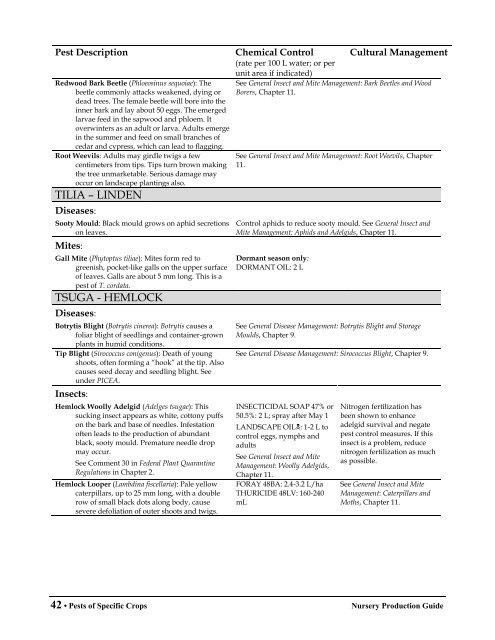Create successful ePaper yourself
Turn your PDF publications into a flip-book with our unique Google optimized e-Paper software.
Pest Description<br />
Redwood Bark Beetle (Phloeosinus sequoiae): The<br />
beetle commonly attacks weakened, dying or<br />
dead trees. The female beetle will bore into the<br />
inner bark and lay about 50 eggs. The emerged<br />
larvae feed in the sapwood and phloem. It<br />
overwinters as an adult or larva. Adults emerge<br />
in the summer and feed on small branches <strong>of</strong><br />
cedar and cypress, which can lead to flagging.<br />
Root Weevils: Adults may girdle twigs a few<br />
centimeters from tips. Tips turn brown making<br />
the tree unmarketable. Serious damage may<br />
occur on landscape plantings also.<br />
TILIA – LINDEN<br />
Diseases:<br />
Sooty Mould: Black mould grows on aphid secretions<br />
on leaves.<br />
Mites:<br />
Gall Mite (Phytoptus tiliae): Mites form red to<br />
greenish, pocket-like galls on the upper surface<br />
<strong>of</strong> leaves. Galls are about 5 mm long. This is a<br />
pest <strong>of</strong> T. cordata.<br />
TSUGA - HEMLOCK<br />
Diseases:<br />
Botrytis Blight (Botrytis cinerea): Botrytis causes a<br />
foliar blight <strong>of</strong> seedlings and container-grown<br />
plants in humid conditions.<br />
Tip Blight (Sirococcus conigenus): Death <strong>of</strong> young<br />
shoots, <strong>of</strong>ten forming a “hook” at the tip. Also<br />
causes seed decay and seedling blight. See<br />
under PICEA.<br />
Insects:<br />
Hemlock Woolly Adelgid (Adelges tsugae): This<br />
sucking insect appears as white, cottony puffs<br />
on the bark and base <strong>of</strong> needles. Infestation<br />
<strong>of</strong>ten leads to the production <strong>of</strong> abundant<br />
black, sooty mould. Premature needle drop<br />
may occur.<br />
See Comment 30 in Federal Plant Quarantine<br />
Regulations in Chapter 2.<br />
Hemlock Looper (Lambdina fiscellaria): Pale yellow<br />
caterpillars, up to 25 mm long, with a double<br />
row <strong>of</strong> small black dots along body, cause<br />
severe defoliation <strong>of</strong> outer shoots and twigs.<br />
Chemical Control<br />
(rate per 100 L water; or per<br />
Cultural Management<br />
unit area if indicated)<br />
See General Insect and Mite Management: Bark Beetles and Wood<br />
Borers, Chapter 11.<br />
See General Insect and Mite Management: Root Weevils, Chapter<br />
11.<br />
Control aphids to reduce sooty mould. See General Insect and<br />
Mite Management: Aphids and Adelgids, Chapter 11.<br />
Dormant season only:<br />
DORMANT OIL: 2 L<br />
See General Disease Management: Botrytis Blight and Storage<br />
Moulds, Chapter 9.<br />
See General Disease Management: Sirococcus Blight, Chapter 9.<br />
INSECTICIDAL SOAP 47% or<br />
50.5%: 2 L; spray after May 1<br />
LANDSCAPE OIL: 1-2 L to<br />
control eggs, nymphs and<br />
adults<br />
See General Insect and Mite<br />
Management: Woolly Adelgids,<br />
Chapter 11.<br />
FORAY 48BA: 2.4-3.2 L/ha<br />
THURICIDE 48LV: 160-240<br />
mL<br />
Nitrogen fertilization has<br />
been shown to enhance<br />
adelgid survival and negate<br />
pest control measures. If this<br />
insect is a problem, reduce<br />
nitrogen fertilization as much<br />
as possible.<br />
See General Insect and Mite<br />
Management: Caterpillars and<br />
Moths, Chapter 11.<br />
42 • <strong>Pests</strong> <strong>of</strong> <strong>Specific</strong> <strong>Crops</strong> Nursery Production Guide
















